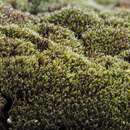Grimmia ovalis is common and widespread in high elevation sites in western North America from southern British Columbia along the Rocky Mountain corridor to southern New Mexico and south central California. H. A. Crum and L. E. Anderson (1981) rejected all reports of
G. ovalis from eastern North America. However, we have seen specimens from that area, although scattered and rare. It is not surprising that the species occurs in the eastern part of the continent given that it is widespread across the Laurasian continental plates and in India. Outlier sites in the Yukon and southern Greenland connect the North American populations to those in Asia and Europe, respectively. In western North America,
G. ovalis is most often confused with
G. longirostris and
G. laevigata. While superficially similar to
G. longirostris,
G. ovalis has concave leaves with plane margins and is dioicous, while
G. longirostris has keeled leaves with a recurved margin and is autoicous. Other points of separation are discussed under
G. longirostris. Typical specimens of
G. ovalis are readily separated from
G. laevigata by their ovate-lanceolate leaves with a well-defined ovate base and narrowly attached awns. However, both of these species are variable in leaf shape, and while the awn of
G. ovalis is usually narrowly attached, sometimes it is quite broad and may border on being decurrent. These specimens can be identified by the width of the costa and the basal areolation.
Grimmia ovalis has a costa that is narrow at the base, while
G. laevigata has a distinctly broad costa covering up to
1/3 of the base. The basal marginal cells of
G. ovalis are most often short- to long-rectangular and hyaline while those of
G. laevigata are always oblate to quadrate and not hyaline. In eastern North America, specimens of
G. ovalis have been misidentified as
G. olneyi. Aside from seta and capsule differences,
G. ovalis has rectangular basal marginal laminal cells and its basal juxtacostal cells are long-rectangular to elongate; see also under
G. olneyi.
Based on identifications by Greven, W. A. Weber et al. (2003) reported Grimmia bernoullii in the United States. That species differs from G. ovalis by its more ovate leaves without shoulders and with plane margins, costa broad at the base and disappearing in mid leaf, and sporophytically by its ellipsoid capsule with long-rostrate, straight operculum, and mitrate calyptra. Hastings has examined duplicate specimens from Missouri of those cited by Weber et al. and has determined that they do not deviate significantly from G. ovalis, having rather narrow leaves, costa narrow at the base and remaining strong in mid leaf, and with many leaves having incurved margins. The specimens were sterile and therefore sporophytic characters could not be determined. Based on these observations Hastings excludes G. bernoullii from the North American flora, although Greven would still retain the species.

